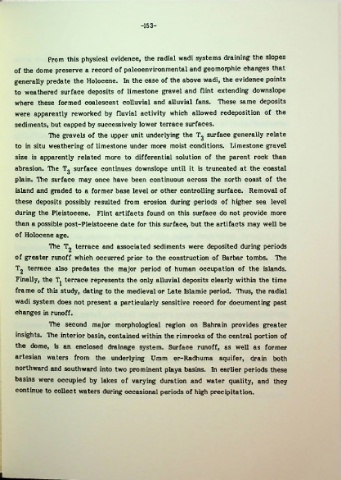Page 177 - Life & Land Use on the Bahrain Islands (Curtis E Larsen)
P. 177
-153-
From this physical evidence, the radial wadi systems draining the slopes
of the dome preserve a record of paleoenvironmental and geomorphic changes that
generally predate the Holocene. In the case of the above wadi, the evidence points
to weathered surface deposits of limestone gravel and flint extending downslope
where these formed coalescent colluvial and alluvial fans. These same deposits
were apparently reworked by fluvial activity which allowed redeposition of the
sediments, but capped by successively lower terrace surfaces.
The gravels of the upper unit underlying the surface generally relate
to in situ weathering of limestone under more moist conditions. Limestone gravel
size is apparently related more to differential solution of the parent rock than
abrasion. The surface continues downslope until it is truncated at the coastal
plain. The surface may once have been continuous across the north coast of the
island and graded to a former base level or other controlling surface. Removal of
these deposits possibly resulted from erosion during periods of higher sea level
during the Pleistocene. Flint artifacts found on this surface do not provide more
than a possible post-Pleistocene date for this surface, but the artifacts may well be
of Holocene age.
The T2 terrace and associated sediments were deposited during periods
of greater runoff which occurred prior to the construction of Barbar tombs. The
T2 terrace also predates the major period of human occupation of the islands.
Finally, the T^ terrace represents the only alluvial deposits clearly within the time
frame of this study, dating to the medieval or Late Islamic period. Thus, the radial
wadi system does not present a particularly sensitive record for documenting past
changes in runoff.
The second major morphological region on Bahrain provides greater
insights. The interior basin, contained within the rimrocks of the central portion of
the dome, is an enclosed drainage system. Surface runoff, as well as former
artesian waters from the underlying Umm er-Radhuma aquifer, drain both
northward and southward into two prominent playa basins. In earlier periods these
basins were occupied by lakes of varying duration and water quality, and they
continue to collect waters during occasional periods of high precipitation.
L

